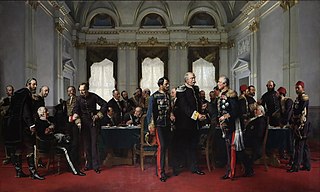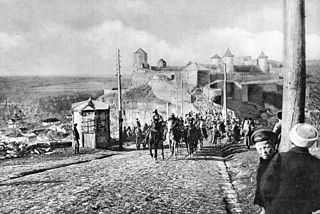Related Research Articles

Austria-Hungary, often referred to as the Austro-Hungarian Empire, the Dual Monarchy, or Austria, was a constitutional monarchy and great power in Central Europe between 1867 and 1918. Austria-Hungary was a military and diplomatic alliance of two sovereign states. It was formed with the Austro-Hungarian Compromise of 1867 in the aftermath of the Austro-Prussian War and was dissolved shortly after its defeat in the First World War.

The Central Powers, also known as the Central Empires, was one of the two main coalitions that fought in World War I (1914–1918). It consisted of the German Empire, Austria-Hungary, the Ottoman Empire, and the Kingdom of Bulgaria and was also known as the Quadruple Alliance.

The Treaty of Brest-Litovsk was a separate peace treaty signed on 3 March 1918 between Russia and the Central Powers, that ended Russia's participation in World War I. The treaty was signed at German-controlled Brest-Litovsk, after two months of negotiations. The treaty was agreed upon by the Russians to stop further invasion. As a result of the treaty, Soviet Russia defaulted on all of Imperial Russia's commitments to the Allies and eleven nations became independent in eastern Europe and western Asia. Under the treaty, Russia lost all of Ukraine and most of Belarus, as well as its three Baltic republics of Lithuania, Latvia, and Estonia, and these three regions became German vassal states under German princelings. Russia also ceded its province of Kars in the South Caucasus to the Ottoman Empire. According to historian Spencer Tucker, "The German General Staff had formulated extraordinarily harsh terms that shocked even the German negotiator." Congress Poland was not mentioned in the treaty. When Germans later complained that the 1919 Treaty of Versailles against Germany was too harsh on them, the Allied Powers responded that it was more benign than the terms imposed by the Brest-Litovsk treaty.

The Treaty of Berlin was signed on 13 July 1878. In the aftermath of the Russian victory against the Ottoman Empire in the Russo-Turkish War of 1877–1878, the major powers restructured the map of the Balkan region. They reversed some of the extreme gains claimed by Russia in the preliminary Treaty of San Stefano, but the Ottomans lost their major holdings in Europe. It was one of three major peace agreements in the period after the 1815 Congress of Vienna. It was the final act of the Congress of Berlin and included Great Britain and Ireland, Austria-Hungary, France, Germany, Italy, Russia and the Ottoman Empire. Chancellor of Germany Otto von Bismarck was the chairman and dominant personality.

The aftermath of World War I saw cultural, economic, and social change across Eurasia, Africa, and even in areas outside those that were directly involved. Four empires collapsed due to the war, old countries were abolished, new ones were formed, boundaries were redrawn, international organizations were established, and many new and old ideologies took a firm hold in people's minds. World War I also had the effect of bringing political transformation to most of the principal parties involved in the conflict, transforming them into electoral democracies by bringing near-universal suffrage for the first time in history, as in Germany, Great Britain, and Turkey.

The Congress of Berlin was a diplomatic conference to reorganise the states in the Balkan Peninsula after the Russo-Turkish War of 1877–78, which had been won by Russia against the Ottoman Empire. Represented at the meeting were Europe's then six great powers: Russia, Great Britain, France, Austria-Hungary, Italy, and Germany; the Ottomans; and four Balkan states: Greece, Serbia, Romania and Montenegro. The congress concluded with the signing of the Treaty of Berlin, replacing the preliminary Treaty of San Stefano that had been signed three months earlier.

The Eastern Front or Eastern Theater of World War I was a theater of operations that encompassed at its greatest extent the entire frontier between Russia and Romania on one side and Austria-Hungary, Bulgaria, the Ottoman Empire, and Germany on the other. It stretched from the Baltic Sea in the north to the Black Sea in the south, involved most of Eastern Europe, and stretched deep into Central Europe as well. The term contrasts with the Western Front, which was being fought in Belgium and France.

The Treaty of Bucharest (1918) was a peace treaty between Romania and the opposing Central Powers following the stalemate reached after the campaign of 1917. This left Romania isolated after Russia's unilateral exit from World War I.

The Bosnian Crisis, also known as the Annexation Crisis or the First Balkan Crisis, erupted on 5 October 1908 when Austria-Hungary announced the annexation of Bosnia and Herzegovina, territories formerly within the sovereignty of the Ottoman Empire but under Austro-Hungarian administration since 1878.

The Treaty of Brest-Litovsk was an exclusive protectorate treaty signed on 9 February 1918 between the Central Powers and the Ukrainian People's Republic, recognizing the latter's sovereignty. It was part of the same negotiations that took place in Brest-Litovsk, Grodno Governorate that also produced the separate treaty of the same name between the Russian Soviet Federative Socialist Republic and the Central Powers on 3 March 1918.
The U.S.–Austrian Peace Treaty is a peace treaty between the United States and Austria, signed in Vienna on August 24, 1921, in the aftermath of the First World War. This separate peace treaty was required because the United States Senate refused to advise and consent to the ratification of the multilateral Treaty of Saint-Germain-en-Laye of 1919.

The Operation Faustschlag, also known as the Eleven Days' War, was a Central Powers offensive in World War I. It was the last major action on the Eastern Front.

The Revolutions of 1917–1923 were a revolutionary wave that included political unrest and armed revolts around the world inspired by the success of the Russian Revolution and the disorder created by the aftermath of World War I. The uprisings were mainly socialist or anti-colonial in nature. Some socialist revolts failed to create lasting socialist states. The revolutions had lasting effects in shaping the future European political landscape, with for example the collapse of the German Empire and the dissolution of Austria-Hungary.

The Armistice of Focșani was an agreement that ended the hostilities between Romania and the Central Powers in World War I. It was signed on 9 December 1917 in Focșani in Romania.

The Ukrainian People's Republic (UPR) was a short-lived state in Eastern Europe. Prior to its proclamation, the Central Council of Ukraine was elected in March 1917 as a result of the February Revolution, and in June, it declared Ukrainian autonomy within Russia. Its autonomy was later recognized by the Russian Provisional Government. Following the October Revolution, the Central Council of Ukraine denounced the Bolshevik seizure of power and proclaimed the Ukrainian People's Republic with a territory including the area of approximately eight Russian imperial governorates. It formally declared its independence from Russia on 22 January 1918.

On 15 December [O.S. 2 December] 1917, an armistice was signed between the Russian Soviet Federative Socialist Republic on the one side and the Austro-Hungarian Empire, the Kingdom of Bulgaria, the German Empire and the Ottoman Empire—the Central Powers—on the other. The armistice took effect two days later, on 17 December [O.S. 4 December]. By this agreement Russia de facto exited World War I, although fighting would briefly resume before the Treaty of Brest-Litovsk was signed on 3 March 1918, and Russia made peace.
The dissolution of Austria-Hungary was a major geopolitical event that occurred as a result of the growth of internal social contradictions and the separation of different parts of Austria-Hungary. The more immediate reasons for the collapse of the state were World War I, the 1918 crop failure, general starvation and the economic crisis. The Austro-Hungarian had additionally been weakened overtime by a widening gap between Magyar and Austrian interests. Furthermore, a history of chronic overcommitment rooted in the 1815 Congress of Vienna in which Metternich pledged Austria to fulfill a role that necessitated unwavering Austrian strength and resulted in overextension. Upon this weakened foundation, additional stressors during World War I catalyzed the collapse of the empire. The 1917 October Revolution and the Wilsonian peace pronouncements from January 1918 onward encouraged socialism on the one hand, and nationalism on the other, or alternatively a combination of both tendencies, among all peoples of the Habsburg monarchy.

The 1918 Austro-Hungarian January strike was a strike which spread across Austria-Hungary between January 3 and 25, 1918 demanding better living and working conditions and an end to World War I. It is known as the "Jännerstreik" as opposed to the "Januarstreik" – a similar strike movement which lasted from 25 January to 1 February 1918 in Germany – Jänner being the usual spelling for January in Austria.
The Treaty of Peace between Finland and Germany, also called the Berlin Peace Treaty, signed in Berlin on 7 March 1918 ended the state of war that existed between Finland and the German Empire as a result of World War I. It paved the way for German intervention in the Finnish Civil War and the invasion of Åland.
References
- 1 2 3 4 Randall Lesaffer and Mieke van der Linden, "Peace Treaties after World War I", in Frauke Lachenmann and Rudiger Wolfrum (eds.), The Law of Armed Conflict and the Use of Force: Articles from The Max Planck Encyclopedia of Public International Law (Oxford University Press, 2017), pp. 910–919, at 911.
- 1 2 3 4 5 Stephan Verosta, "Peace treaties after World War I", in Rudolf Bernhardt (ed.), Encyclopedia of Public International Law 4: Use of Force – War and Neutrality – Peace Treaties (N–Z) (North Holland, 1982), pp. 110–117, at 112.
- ↑ Jaakko Uotila, The Finnish Legal System (Suomen lakimiesliiton kustannus, 1966), p. 249.
- ↑ Treaty of Peace and Amity between Bulgaria and Finland, signed at Berlin, 21 May 1918, Oxford Historical Treaties, Oxford Public International Law.
- 1 2 3 4 Texts of the Finland "Peace": With Map (Washington, D.C.: Government Printing Office, 1918), pp. 47–48 (German text of treaty with English translation).
- ↑ Convention between Austria-Hungary and Finland concerning Certain Questions of Private Law supplementary to the Treaty of Peace, signed at Vienna, 29 May 1918, Oxford Historical Treaties, Oxford Public International Law.